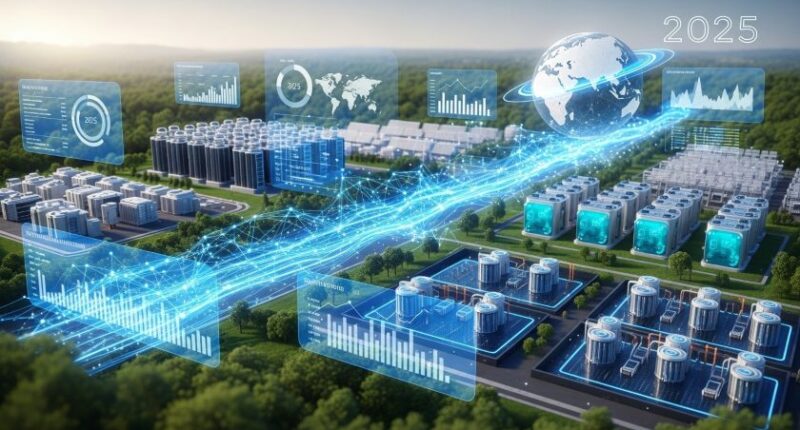The year 2025 marks a significant pivot in the renewable-energy sector. The first decade of explosive capacity growth — installing solar panels and wind turbines by the gigawatt — is effectively giving way to a new phase: one where system integration, storage, digital controls and lifecycle management are just as critical as raw megawatts. As the International Energy Agency (IEA) notes, while new capacity continues to surge, the major bottleneck has shifted toward how clean energy is delivered and managed. IEA+1
In many regions, the question is no longer “How much renewable energy can we build?” but “How reliably, efficiently and sustainably can we operate it?”
Below, I dive into five key dynamics defining this phase, why emerging markets have a unique opportunity, and how developers/investors should adjust strategy accordingly.
1. From build-out to integration & dispatchability
Until recently, the narrative around renewable energy was dominated by volume: how many megawatts of solar or wind capacity could be installed. But in 2025, the value proposition is evolving.
The IEA’s Renewables 2025 analysis emphasises that although capacity deployment remains strong, the integration of that capacity into grids, markets and systems is the major challenge ahead. IEA
For example, as more variable generation comes online, power systems increasingly require means to manage when and how that power is delivered — midday solar surges must be balanced with evening peaks, wind drops must be accommodated with storage or alternative flexibility. This means storage, smart controls and grid modernisation become mission-critical.
2. Storage as the linchpin of resilient renewable systems
The rise of storage is one of the clearest signals of this phase-shift. Large-scale batteries, long-duration storage (multi-hour, day-long), hybrid systems and grid-edge technologies are now core to renewable value—not extra features.
According to research from the cleantech sector, installations of long-duration energy storage (LDES) are expected to more than double in 2025 compared to 2024. S&P Global+1
Storage enables renewables to act like “firm power” rather than strictly variable generation. That enables utilities and grid operators to treat clean energy assets on more equal footing with conventional power plants. For investors and developers, this means project selection must emphasise hours of delivery, not just capacity numbers.
3. Digitalisation, decentralisation and system value
Alongside storage, digital technologies such as AI forecasting, micro-grid controls, decentralised energy networks and asset-health management are becoming standard.
In practical terms:
-
Solar farms now deploy advanced forecasting to predict generation and calibrate storage discharge.
-
Community energy systems combine rooftop PV, local batteries and grid-services participation — shifting value closer to consumption nodes.
-
Developers increasingly win contracts not just on build cost, but on long-term performance, data analytics and lifecycle optimisation.
For emerging markets with weaker grids or more fragmented systems, these decentralised plus digital models offer strong advantage (faster deployment, better resilience, lower grid-dependency).
4. Emerging markets: Leap-frogging the fossil infrastructure trap
One of the most exciting dynamics in 2025 is the acceleration of renewables in emerging regions. According to the McKinsey “Taking Stock” 2025 review, emerging economies (excluding China) installed more new solar + wind capacity in first half of 2025 than the EU or US. McKinsey & Company
For countries such as Myanmar, Vietnam, Indonesia, many of the grid-infrastructure challenges remain un-solved—but they also offer a major opportunity: instead of replicating legacy fossil-centric systems, they can build clean systems from the ground up, embedding storage, digital controls and decentralised architecture from day one.
The message: Don’t just aim to install renewable capacity. Aim to install a resilient, flexible system.
5. Lifecycle thinking, circular economy & the next frontier
With rapid build-out over the past decade, the industry must now prepare for the next phase: asset lifecycle, repowering, recycling and legacy management.
Academic work identifies that as the deployment boom peaks, the renewal phase becomes dominant — meaning projects must plan not just for construction and commissioning, but for longevity, maintenance, reuse and end-of-life management. arXiv
For investors this adds new dimensions of risk and opportunity: second-life batteries, recycling of panels, smart-asset health platforms become part of the value chain. Long-term returns will favour projects that anticipate the full asset life, not just build-fast.
What this means for strategy: developers, investors & policymakers
Developers
-
Shift metrics from MW installed to MWh delivered, reliability and performance.
-
Value storage as integral, not optional — design systems for dispatchability.
-
Embrace digital asset-management tools, lifecycle services, and performance-contracts.
Investors
-
View project risk in terms of hours of delivery, grid-services revenue and system resilience, not just build cost.
-
Seek assets that include storage, hybridisation, digital analytics and flexibility.
Policymakers
-
Incentivise dispatchability and flexibility, not only capacity additions.
-
Upgrade grid regulation, standards, and market design to reward storage, micro-grids and digital systems.
-
Support local manufacturing, circular-economy frameworks (recycling, repowering) and skills development.
Key take-aways for Myanmar & Southeast Asia
For Myanmar and neighbouring ASEAN markets, the global trends point to a strategic roadmap:
-
Scale solar quickly, but pair with storage to avoid system bottlenecks.
-
Invest in grid modernisation, digital-controls and decentralised energy solutions alongside capacity build-out.
-
Focus on local capability: assembly, maintenance, digital services, circular economy.
-
Structure policy and PPA frameworks that reward reliability, flexibility and full-system performance.
This approach allows emerging markets to leap ahead — not just in capacity but in system value, resilience and competitive advantage.









